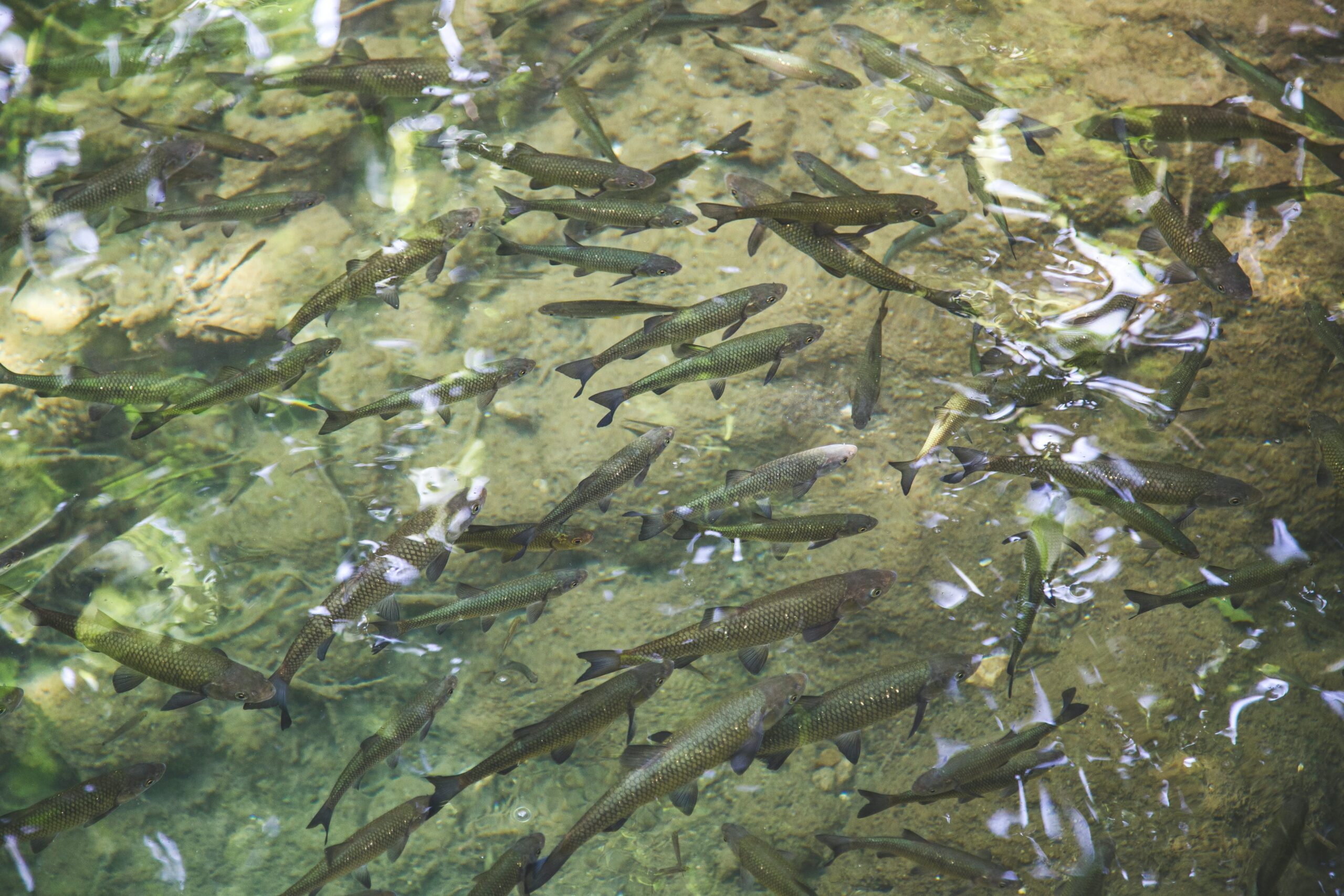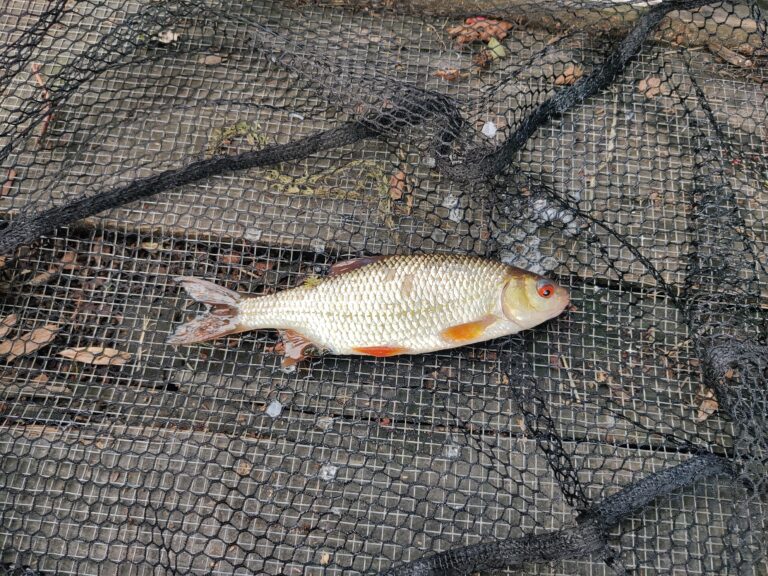Coarse fishing offers a diverse range of Common Coarse Fish species that anglers can target in freshwater environments. Each species has its own unique characteristics, preferred fishing methods, and favoured baits. In this article, we will explore some of the most common coarse fish species, organized by average size, providing information on hook sizes, fishing methods, preferred baits, common waterways, and likely locations within the water.
Table of Contents
Common Coarse Fish
Rudd
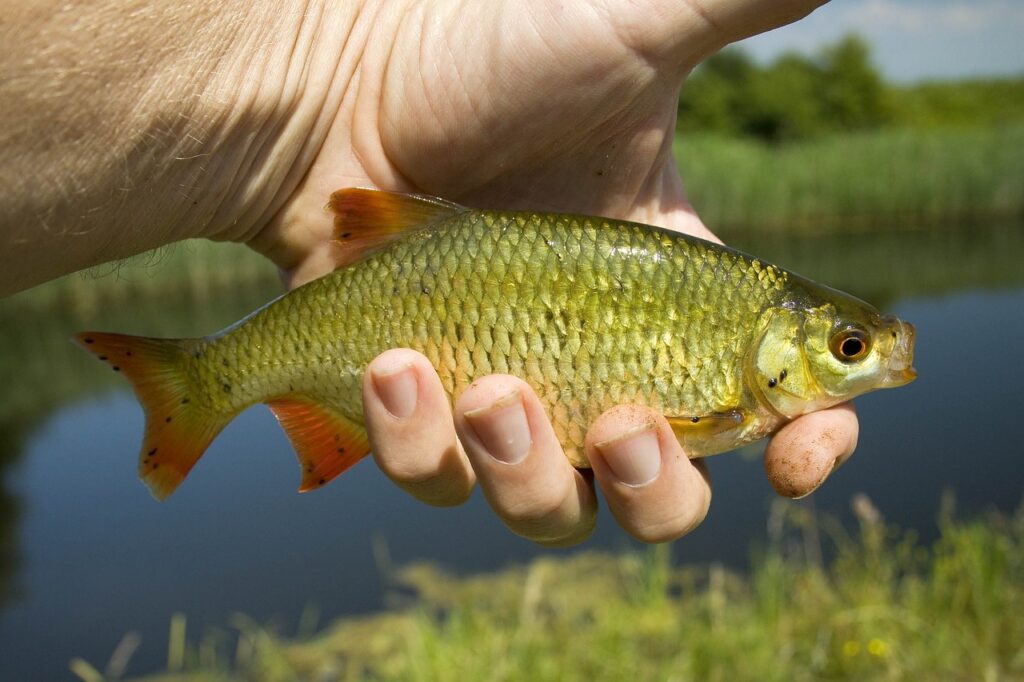
- Description – Rudd have a deep, laterally compressed body with a bright silver coloration. They have a high, arched back and a forked tail
- Size – Rudd typically range from a few ounces to around 1 lb (0.5 kg)
- Hook Size – Use smaller hooks in the range of size 14 to 18
- Fishing Method – Float fishing is a popular method for targeting Rudd, allowing for precise presentation and control
- Preferred Baits – Rudd are often attracted to baits such as bread, maggots, casters, or small artificial lures
- Common Waterways – Rudd can be found in stillwater, lakes, and slow-moving rivers throughout the UK
- Likely Locations – Look for Rudd in open water areas with vegetation, near overhanging trees, or lily pads. They are often found in midwater or close to the surface, particularly in warmer months
- Key Characteristics – Rudd have a reddish-orange or yellowish tinge on their fins, particularly the pectoral, pelvic, and anal fins. They have a relatively small mouth and a red iris in their eyes. Rudd have a single dorsal fin and a small, black spot near the base of their pectoral fin.
Roach
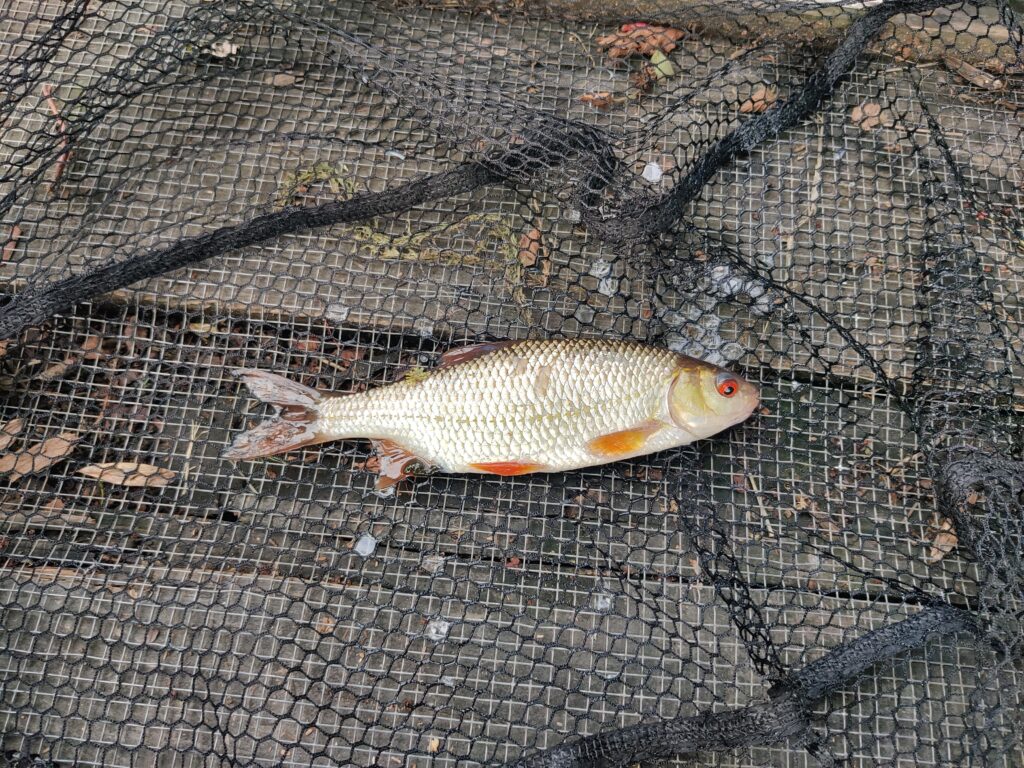
- Description – Roach have a silver-coloured body with greenish-blue hues on their backs. They have a slender, torpedo-shaped body and a small, underslung mouth
- Size – Roach typically range from a few ounces to around 1 lb (0.5 kg)
- Hook Size – Use smaller hooks in the range of size 14 to 18
- Fishing Method – Float fishing is a popular method for targeting roach, allowing for precise presentation and control
- Preferred Baits – Roach are often attracted to baits such as maggots, casters, bread punch, or sweetcorn
- Common Waterways – Roach can be found in rivers, canals, and stillwater throughout the UK
- Likely Locations – Look for roach in open water or near features such as overhanging trees, marginal vegetation, or lily pads. They are commonly found in midwater or close to the bottom
- Key Characteristics – Roach have red-orange eyes, a blackish-brown dorsal fin, and a deeply forked tail. They are known for their large, reflective scales and prominent red/orange coloration on their fins
Perch
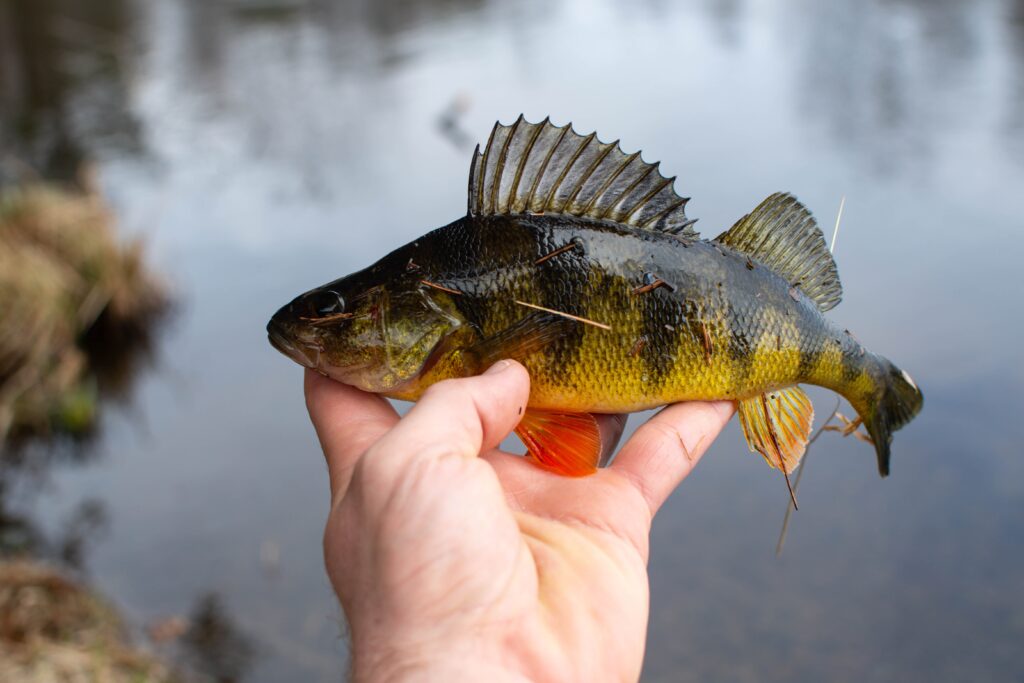
- Description – Perch have a distinctive appearance with a spiny dorsal fin and a relatively deep, laterally compressed body. They have greenish backs with dark vertical bars, while their bellies are usually a bright white or yellowish colour
- Size – Perch can range from a few ounces to over 4 lb (2 kg)
- Hook Size – Use hooks in the range of size 8 to 12
- Fishing Method – Perch can be caught using a variety of methods, including float fishing, ledgering, or spinning
- Preferred Baits – Perch are attracted to baits such as worms, small fish, maggots, or artificial lures
- Common Waterways – Perch inhabit rivers, canals, lakes, and reservoirs across the UK
- Likely Locations – Look for perch near structures like submerged trees, bridge pillars, or weed beds. They can be found in different parts of the water column, from close to the bottom to midwater
- Key Characteristics – Perch have a large mouth with sharp teeth, and their eyes are reddish-orange or yellow. They have two dorsal fins, the first being spiny, and the second being soft and rounded
Chub
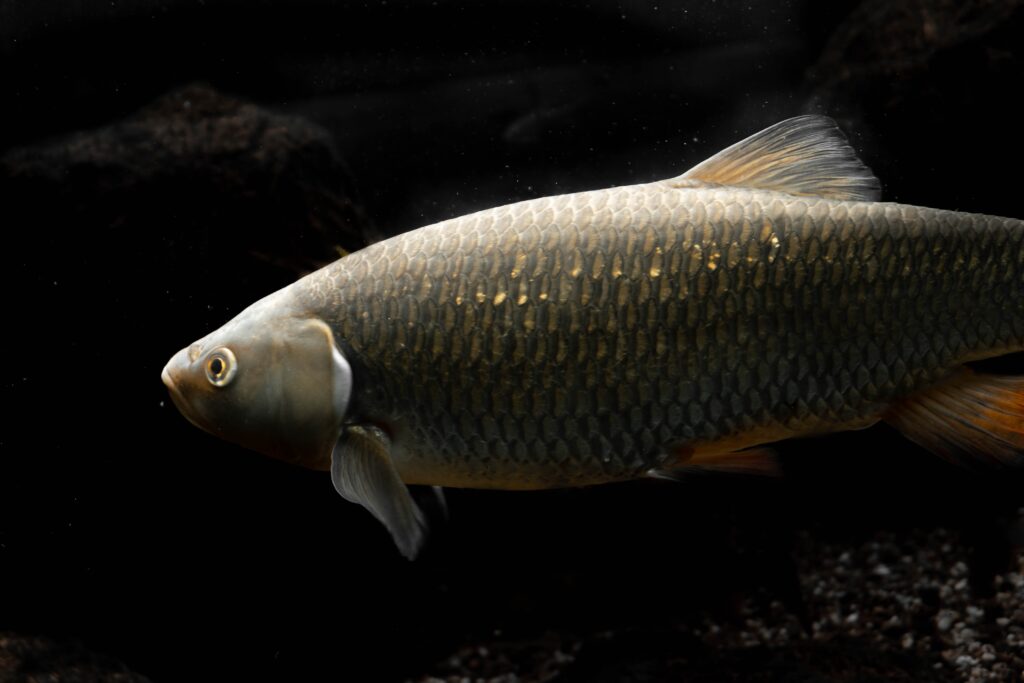
- Description – Chub is a popular coarse fish species known for its streamlined body and deep, rounded shape. It has a dark olive-green to brownish coloration on its back, fading to a golden hue on the sides. Chub have a large, powerful mouth and a distinct, forked tail
- Size – Chub can grow to impressive sizes, with adults commonly reaching 14 to 22 inches (35 to 55 cm) in length and weighing 2 to 6 pounds (0.9 to 2.7 kg). Exceptional specimens may exceed 7 pounds (3.2 kg)
- Hook Size – When targeting chub, a recommended hook size is around 8 to 12, depending on the bait used and the fish’s size
- Fishing Method – Chub can be caught using various fishing methods, but the most popular approaches are float fishing and ledgering. Float fishing with a light to medium float rig allows for precise presentation in different water depths. Ledgering involves using a weighted setup, allowing the bait to settle on the bottom where chub often feed
- Preferred Baits – Chub are opportunistic feeders, and they will readily take a wide range of baits. Preferred baits include worms, maggots, casters, bread, cheese, luncheon meat, and artificial baits such as soft plastic lures. Experimenting with different baits can help determine what works best on the day
- Common Waterways – Chub are widespread in rivers and streams throughout the UK. They can be found in both slow-moving and faster-flowing waters, often in areas with cover such as overhanging trees, undercut banks, and underwater structures
- Likely Locations – Chub are known for their preference for cover and can often be found near features that provide shelter and ambush points. Look for them near submerged branches, snags, overhanging vegetation, and areas with deeper pools. Chub are also drawn to areas where food is abundant, such as near weed beds or where small streams enter the main river
- Key Characteristics – Chub can be distinguished by their deep, rounded body shape, large mouth, and forked tail. They have a golden hue on their sides and an olive-green to brownish coloration on their back. Chub often exhibit a distinct, dark lateral line running horizontally along their body. Their overall appearance and stocky build set them apart from other coarse fish species.
Tench
- Description – Tench have a stout, laterally compressed body with a dark green or olive-brown coloration. They have a thick, fleshy body shape and large scales
- Size – Tench can range from a few ounces to over 8 lb (4 kg)
- Hook Size – Use larger hooks in the range of size 8 to 12
- Fishing Method – Tench can be targeted using methods such as float fishing, ledgering, or feeder fishing
- Preferred Baits – Tench are attracted to baits such as worms, maggots, casters, sweetcorn, or pellets
- Common Waterways – Tench can be found in stillwater, ponds, and some slow-flowing rivers
- Likely Locations – Tench are often found in weedy areas, close to marginal vegetation or lily pads. They can be caught at different depths, from close to the bottom to midwater
- Key Characteristics – Tench have small, reddish eyes and rounded fins. They are known for their slime-coated skin, which helps protect them in muddy or weedy habitats. Tench have a small, downturned mouth and a deeply forked tail
Bream
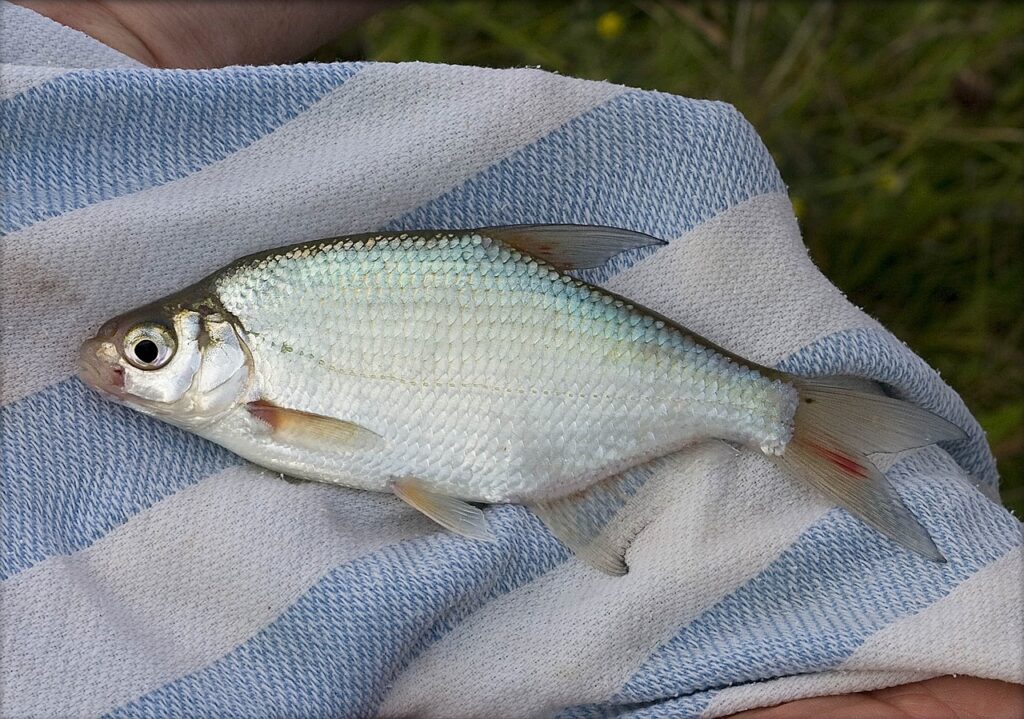
- Description – Bream have a deep, laterally compressed body with a slightly arched back. They are silver-grey in colour with a silvery-white belly. Bream have large scales and a small, downward-facing mouth
- Size – Bream can range from a few ounces to over 10 lb (5 kg)
- Hook Size – Use larger hooks in the range of size 10 to 14
- Fishing Method – Bream can be targeted using methods such as feeder fishing, ledgering, or float fishing
- Preferred Baits – Bream are often attracted to baits like maggots, worms, corn, or pellets
- Common Waterways – Bream can be found in rivers, canals, and stillwater across the UK
- Likely Locations – Bream tend to feed on or near the bottom. Look for them in deeper areas of stillwater or slower-moving sections of rivers and canals
- Key Characteristics – Bream have a single dorsal fin and a deeply forked tail. They have a slightly protruding lower jaw and a dark-coloured spot on their gill cover. Their eyes are proportionally smaller in relation to their body size
Barbel
- Description – Barbel have a streamlined, elongated body with a dark olive or bronze coloration. They have a slim, muscular profile and a long, flat head
- Size – Barbel can range from a few pounds to over 15 lb (7 kg) or more
- Hook Size – Use larger hooks in the range of size 6 to 10, depending on the bait and fish size
- Fishing Method – Barbel are often targeted using feeder fishing or ledgering techniques
- Preferred Baits – Barbel are attracted to baits such as pellets, boilies, worms, maggots, or meaty offerings
- Common Waterways – Barbel can be found in rivers and larger stillwater across the UK, with notable populations in the rivers Severn, Trent, and Wye
- Likely Locations – Look for barbel in deeper sections of rivers, near features such as bridge pillars, gravel bars, or undercut banks. They are bottom-feeders and often inhabit areas with a strong flow
- Key Characteristics – Barbel have a pair of barbels around their mouth, which aid in locating food through touch and smell. They have a long dorsal fin with serrated spines and a deeply forked tail. Their pectoral and pelvic fins are strong and well-developed
Carp
- Description – Carp have a robust, elongated body with a dark olive-green or brownish coloration. They have large, cycloid scales and a thick-set appearance
- Size – Carp can range from a few pounds to well over 30 lb (15 kg) or more
- Hook Size – Use larger hooks in the range of size 8 to 12, depending on the carp size
- Fishing Method – Carp can be targeted using various methods, including float fishing, ledgering, or feeder fishing
- Preferred Baits – Carp are attracted to a wide range of baits, including boilies, pellets, sweetcorn, bread, or worms
- Common Waterways – Carp can be found in lakes, ponds, canals, and rivers throughout the UK
- Likely Locations – Carp are often found in the deeper parts of stillwater, close to features such as islands, overhanging trees, or reed beds. They can be caught at different depths and respond to different feeding strategies
- Key Characteristics – Carp have a downward-facing mouth with four barbels on each side of the upper lip. They have a long, curved dorsal fin and a deeply forked tail. Carp can vary in coloration depending on their environment, with some displaying a golden or bronze hue
Remember to check local angling regulations and obtain the necessary permits when fishing for coarse fish. Additionally, always handle fish with care and return them safely to the water after capture.
Understanding the characteristics, fishing methods, preferred baits, and likely locations for common coarse fish species will enhance your angling experience and increase your chances of success. Enjoy exploring the diverse world of coarse fishing and the opportunities it presents for catching these fascinating fish species.

